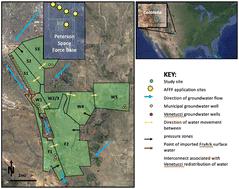当前位置:
X-MOL 学术
›
Environ. Sci.: Processes Impacts
›
论文详情
Our official English website, www.x-mol.net, welcomes your feedback! (Note: you will need to create a separate account there.)
Estimating historical exposure to perfluoroalkyl acids in Security, Fountain, and Widefield Colorado: use of water-infrastructure blending and toxicokinetic models
Environmental Science: Processes & Impacts ( IF 5.5 ) Pub Date : 2023-04-20 , DOI: 10.1039/d2em00337f Jessica Meeks 1, 2, 3 , Sarah Mass 3 , John L Adgate 4 , Kelsey Barton 4 , Kamini Singha 1, 2, 3 , John E McCray 1, 3 , Anne P Starling 4, 5 , Christopher P Higgins 1, 3
Environmental Science: Processes & Impacts ( IF 5.5 ) Pub Date : 2023-04-20 , DOI: 10.1039/d2em00337f Jessica Meeks 1, 2, 3 , Sarah Mass 3 , John L Adgate 4 , Kelsey Barton 4 , Kamini Singha 1, 2, 3 , John E McCray 1, 3 , Anne P Starling 4, 5 , Christopher P Higgins 1, 3
Affiliation

|
Drinking water can be a major source of poly- and perfluoroalkyl substance (PFAS) exposure for humans. The lack of historic data on PFAS drinking-water concentrations and consumption patterns are a limiting factor for developing estimates of past exposure. Here, in contribution to a community-scale PFAS health effects study near fire training facilities that contaminated a local aquifer with PFASs, we present a novel water-infrastructure, mass-balance mixing model coupled to a non-steady state, single-compartment toxicokinetic model that used Monte Carlo simulations to estimate the start of PFAS exposure in drinking water for individuals within three PFAS-impacted communities in El Paso County, Colorado. Our modeling focused on perfluorohexane sulfonic acid (PFHxS) because median serum PFHxS concentrations in a sample of local residents (n = 213) were twelve times the median observed in the U.S. National Health and Nutrition Examination Survey (2015–2016). Modeling results for study participants were grouped according to their community of residence, revealing a median start of exposure for the town of Fountain of 1998 (25–75% interquartile range [IQR], 1992 to 2010), 2006 (IQR 1995 to 2012) for Security, and 2009 (IQR 1996–2012) for Widefield. Based on the towns' locations relative to an identified hydraulically upgradient PFAS source, the modeled exposure sequencing does not completely align with this conceptual flow model, implying the presence of an additional PFAS source for the groundwater between Widefield and Fountain.
中文翻译:

估计科罗拉多州安全、喷泉和威德菲尔德的全氟烷基酸历史暴露:使用水-基础设施混合和毒代动力学模型
饮用水可能是人类接触多氟烷基物质和全氟烷基物质 (PFAS) 的主要来源。缺乏关于 PFAS 饮用水浓度和消费模式的历史数据是制定过去接触估计的限制因素。在这里,为了促进社区规模的 PFAS 健康影响研究,该研究靠近用 PFAS 污染了当地含水层的消防训练设施,我们提出了一种新的水基础设施、质量平衡混合模型,耦合到非稳态、单室毒代动力学该模型使用蒙特卡洛模拟来估计科罗拉多州埃尔帕索县三个受 PFAS 影响的社区内个人饮用水中 PFAS 暴露的开始。我们的建模侧重于全氟己烷磺酸 (PFHxS),因为当地居民样本中的血清 PFHxS 浓度中位数 (n = 213) 是美国国家健康和营养检查调查(2015-2016 年)中观察到的中位数的 12 倍。研究参与者的建模结果根据他们居住的社区进行分组,揭示了喷泉镇 1998 年(25-75% 四分位距 [IQR],1992 年至 2010 年)、2006 年(IQR 1995 至 2012 年)开始接触的中位数用于安全,2009 (IQR 1996–2012) 用于 Widefield。根据城镇相对于已确定的水力提升 PFAS 源的位置,建模的暴露顺序与该概念流动模型并不完全一致,这意味着 Widefield 和 Fountain 之间的地下水存在额外的 PFAS 源。
更新日期:2023-04-20
中文翻译:

估计科罗拉多州安全、喷泉和威德菲尔德的全氟烷基酸历史暴露:使用水-基础设施混合和毒代动力学模型
饮用水可能是人类接触多氟烷基物质和全氟烷基物质 (PFAS) 的主要来源。缺乏关于 PFAS 饮用水浓度和消费模式的历史数据是制定过去接触估计的限制因素。在这里,为了促进社区规模的 PFAS 健康影响研究,该研究靠近用 PFAS 污染了当地含水层的消防训练设施,我们提出了一种新的水基础设施、质量平衡混合模型,耦合到非稳态、单室毒代动力学该模型使用蒙特卡洛模拟来估计科罗拉多州埃尔帕索县三个受 PFAS 影响的社区内个人饮用水中 PFAS 暴露的开始。我们的建模侧重于全氟己烷磺酸 (PFHxS),因为当地居民样本中的血清 PFHxS 浓度中位数 (n = 213) 是美国国家健康和营养检查调查(2015-2016 年)中观察到的中位数的 12 倍。研究参与者的建模结果根据他们居住的社区进行分组,揭示了喷泉镇 1998 年(25-75% 四分位距 [IQR],1992 年至 2010 年)、2006 年(IQR 1995 至 2012 年)开始接触的中位数用于安全,2009 (IQR 1996–2012) 用于 Widefield。根据城镇相对于已确定的水力提升 PFAS 源的位置,建模的暴露顺序与该概念流动模型并不完全一致,这意味着 Widefield 和 Fountain 之间的地下水存在额外的 PFAS 源。



























 京公网安备 11010802027423号
京公网安备 11010802027423号